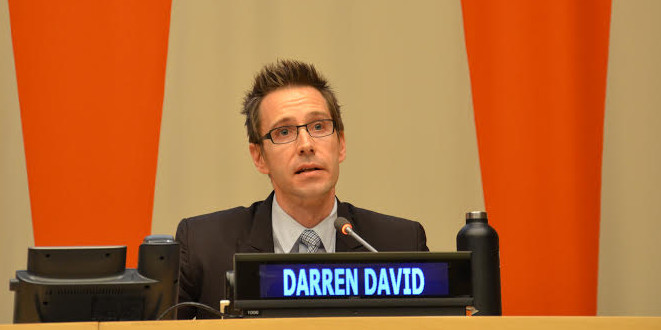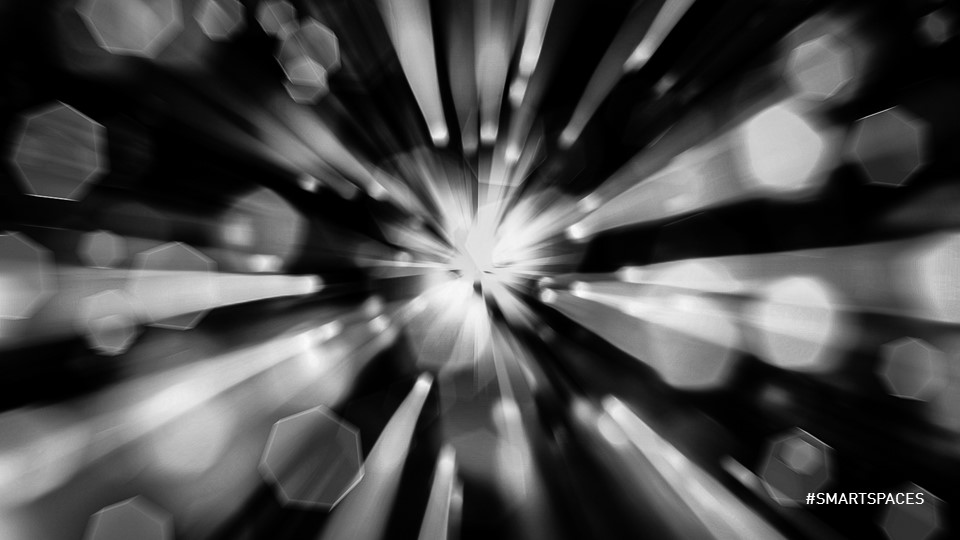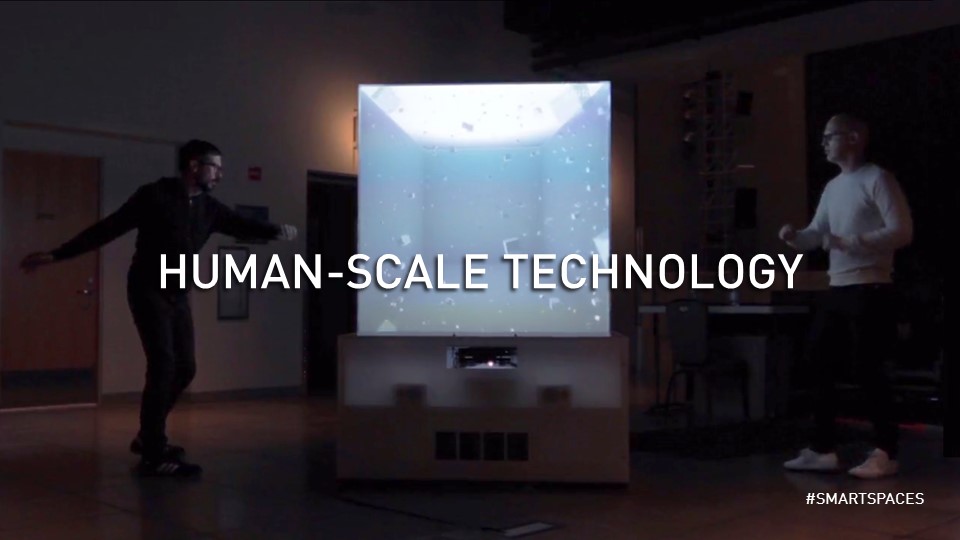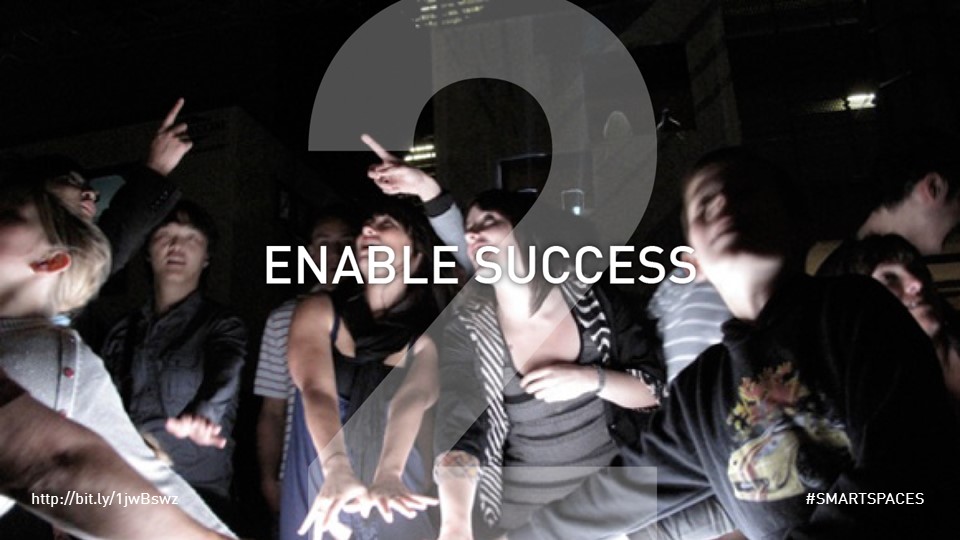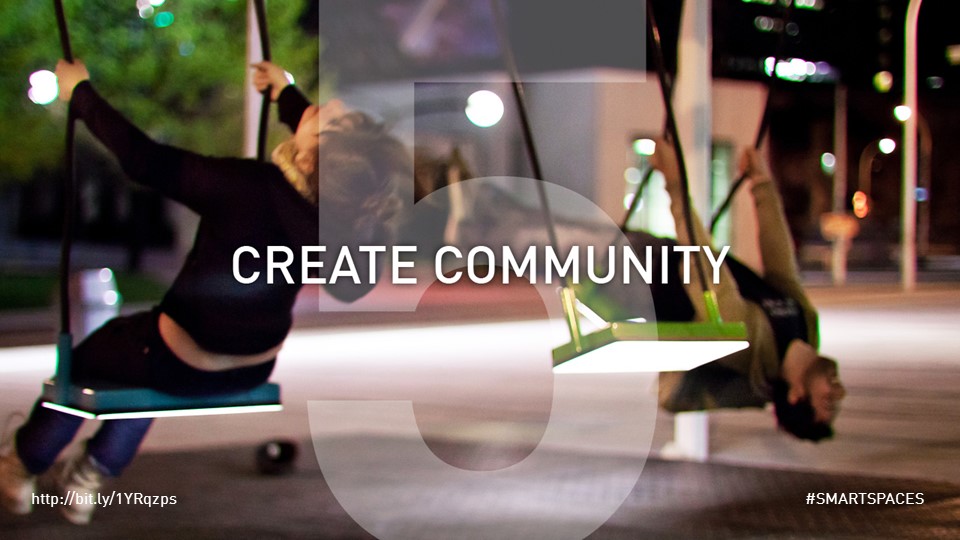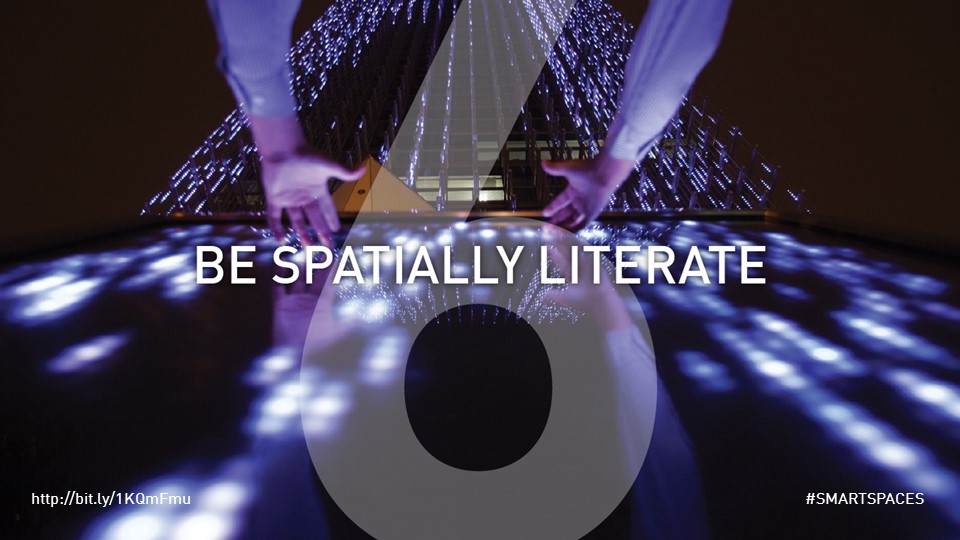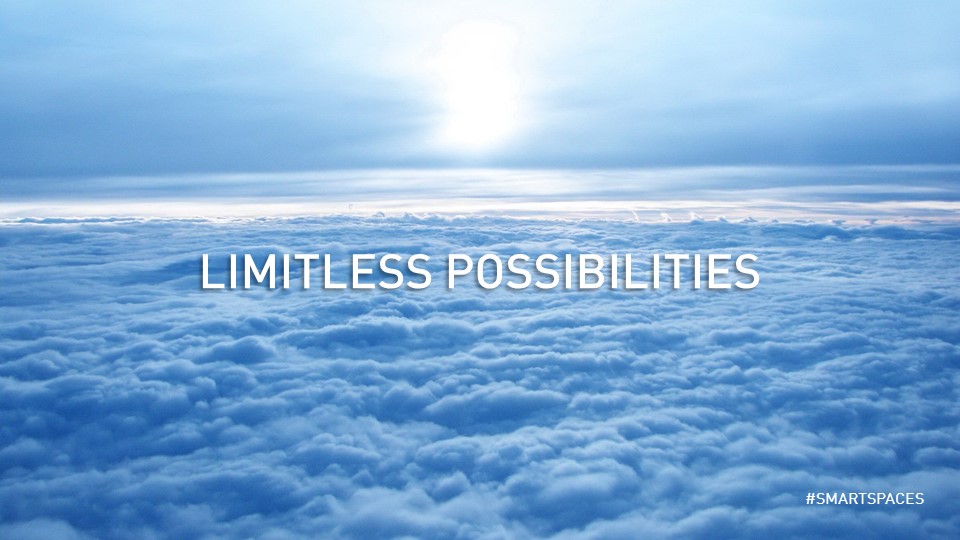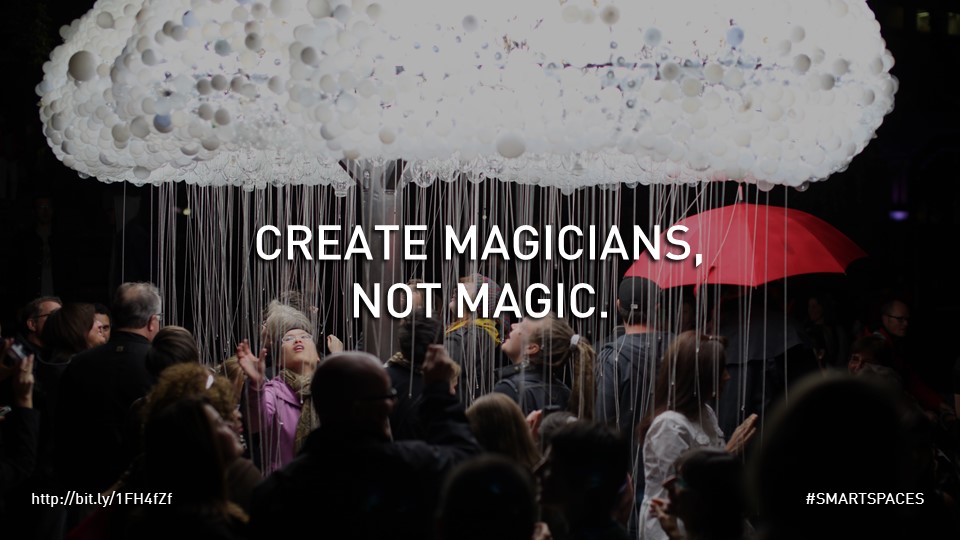On Monday, October 5, our CEO Darren David was invited to speak on a panel at the United Nations in celebration of World Habitat Day and this year’s theme, Public Spaces for All. Smart spaces are a new category of space that merge the best of the digital world with the built environment, creating places of wonder that appeal to the always-on, always-connected population. In this talk, we present some of our favorite examples of smart spaces, along with 8 principles for designing public spaces.
You can watch the presentation at the UN here (our talk is at 37:57); the full presentation is available below.
Good afternoon, everyone! My name is Darren David, and I hold the belief that a joyous and harmonious relationship with our surroundings and with fellow humans is the foundation to happiness.
But I’m not an urban planner, or an architect, or a diplomat. I’m a creative technologist from San Francisco, which is a fancy way of saying that I work closely with people like yourselves to find unique ways to leverage technology to solve problems.
For the past 8 years, Stimulant has endeavored to enable these relationships through human-scale interactive experiences that connect people and place in new ways. It’s a nascent field we call “smart space design,” and it has the potential to rekindle a dying appreciation for physical places, and ultimately rekindle our excitement for connecting with each other in the real world.
We’ve seen a logarithmic increase in the pace of innovation over the last two decades. 3.2 billion people today worldwide use the Internet, close to 2 billion users worldwide have smartphones and around 2 billion are active users on social networks. The energy and time it takes to reach one person or hundreds of millions of people across the globe is miniscule compared to what it was even 30 years ago.
We can follow our passions, find others who share them, and exchange ideas and aspirations freely.
Thousands of new online communities are created daily.
If we don’t like something about our digital environment, we change it — or simply jump into a new one with a few clicks or taps.
We’re no longer bound by the limits of location or space, and can even assume completely different personas if we feel limited by our corporeal forms.
The virtual world is one of creativity and infinite possibility, and it’s no wonder it has captured the attention of billions.
Before the advent of a global, digital network, public space was the social network of the day. With the arrival of the Internet, though, the realities of distance and location no longer matter for the immediate dissemination of ideas.
Technology has become the new public space, and we have retreated to our screens to communicate and create with others en masse. While we might live out our lives and dreams online, ultimately we must engage with the real world. But while technology has raised our expectations around what is possible with communities and interaction, the real world has yet to catch up.
Technology is no longer a nice-to-have, it is now an expectation for those who have access to it (or who are aware of what they’re missing).
The tipping point for smartphones brought along an expectation that any screen outside of one’s home could or should respond to touch.
Our personal devices carry more computing power than a supercomputer did 30 years ago, in our pocket, and have opened our minds to incredible new ways to create and consume content — complex mobile applications leveraging cutting edge graphics, physical simulation, amazing sound and graphics are now available to the mainstream, not just elite computer enthusiasts.
Computer games have replaced playing outside for many children in industrialized nations.
Science fiction opens our eyes to new ways to interact with technology, and real-world versions of the same trail only slightly behind.
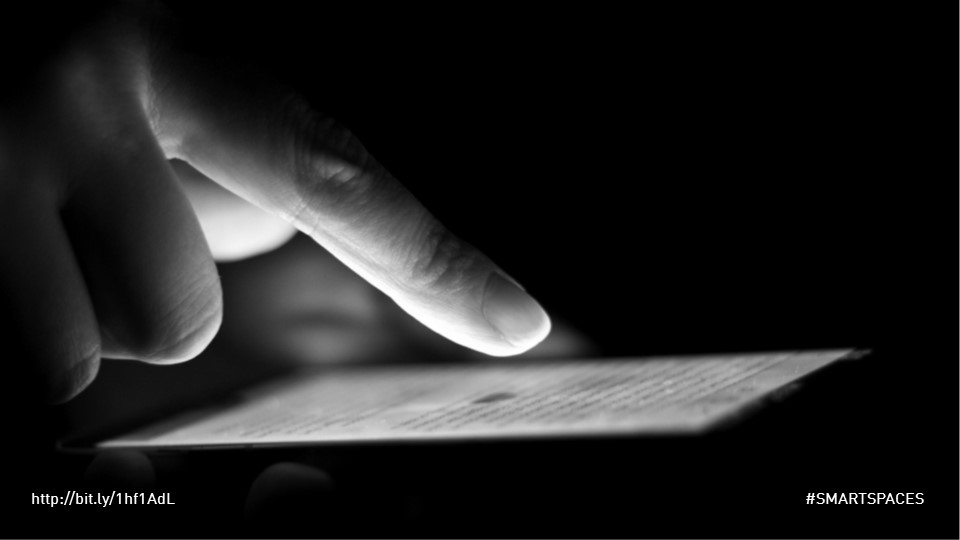
The virtual world is the stuff of magic and dreams, and the real world, it seems, has become, well, boring. I mean, why would I hang out outside when all of my friends are online? Why would I seek out a physical location when I can virtually transport myself into a myriad of locations with ease?
And that raises the big question for today: How can we create public spaces that appeal to the always-on, always-connected populace?
A few years ago the city of Montreal, Quebec had an unused strip of public space behind their opera house that they wanted to activate for their community. The space was built to be open to possibility, but their first commission was working with a local design team that held aloft the idea of collaboration as their ultimate goal. They set out to create an experience that anyone could understand and use, but rewarded cooperation in magical ways. The end result was 21 Balancoires (21 Swings), a human-scale musical instrument. Swing to play notes, but synchronize your swinging with others to reveal more complex melodies. The installation turned an activity that everyone knew into something that was simultaneously intuitive, delightful and social. And it succeeded in spades – the temporary installation has been retrofitted for permanent use, and portable versions now travel the world. The smiles speak for themselves. It elevated a humble public space into something new — a smart space.
In another example, a Stockholm subway staircase was transformed into a set of piano keys, encouraging people to take the stairs instead of the escalator, and 66% of people opted to take the stairs because it was more fun.
Here is an example from our own work. We love electronic music, but we’ve found the audiences at these shows can be glued to their phones. People love dancing and enjoying the music, but they tend to stay in their own shell. So we created an experience that had the simplest instructions ever – just dance – and we dropped it in the middle of a massive dancefloor. When you dance you get a fun avatar of yourself, but when someone approaches from the opposite side, your avatar’s hands are connected with those of the other avatar. Suddenly, you’re dancing together, synchronizing your moves to create beautiful rhythmic patterns. We used technology to break the ice, get people dancing with each other that never would have before, and even created some new friendships!
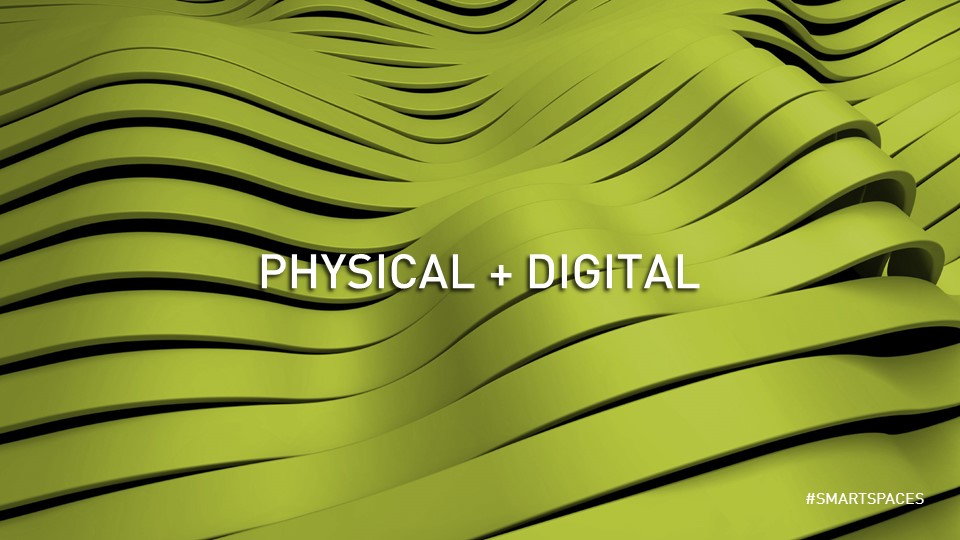
Smart spaces merge the best parts of the digital world with physical space.
They turn static environments into enlightened environments.
They reward our curiosity with magical responses to natural inputs.
They turn a place from a container of conversation into a participant in that conversation.
A smart space doesn’t monetize, it mesmerizes — it exceeds our expectations by changing perceptions of what a physical space can do.
It can use technology to give back to us what online technology has taken away from us – our physicality. It completely recalibrates our idea of how we relate to and interact with our environment, and speaks to us at human-scale.
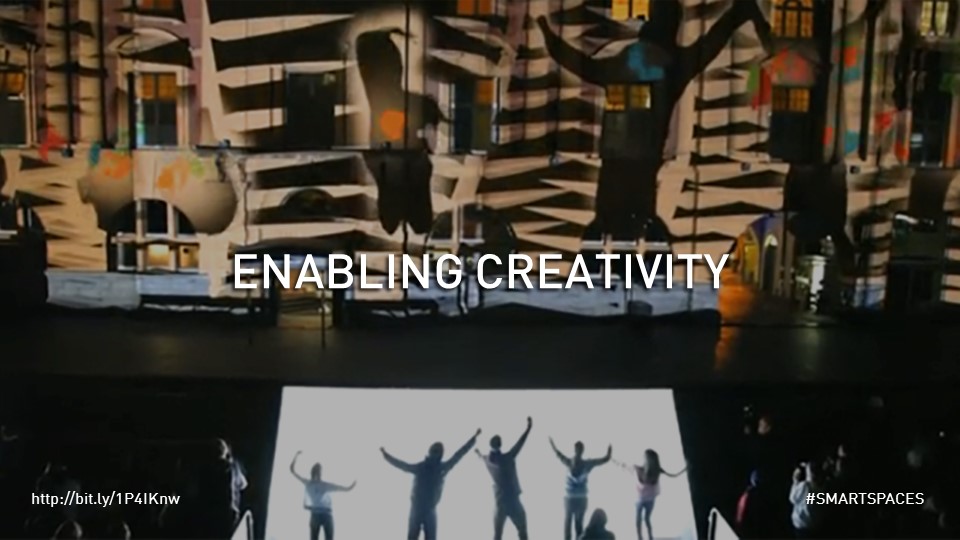
Ultimately, we’re creating environments that give people the tools to be creative in their own unique way. Creative expression is foundational to well-being, but not everyone feels like they can be creative — we strive to create environments that turn even the most self-doubting curmudgeon into a flourishing artistic virtuoso. Smart spaces challenge perceptions of the limitations of physical space by creating experiences that exceed our expectations — swings that encourage cooperation, stairs that turn commuters into composers and glowing rectangles that actually bring us closer to those around us, not come between us.

The examples I’ve shown illustrate that smart public spaces need not be complex in their form or implementation, but simplicity in appearance belies a careful and methodical design approach. We have to think not about technology, but about experiences, and work backwards from our ultimate goal. Smart spaces take a lot of creativity and effort to create, and the key is planning for them from the very beginning of a project. I’d like to share some of our core principles for creating smart spaces that can be applied to any public space project.

Begin at the Beginning. Successful smart spaces consider the overall experience and technology from the very beginning of the concepting process, not at the end after the space has been designed. It’s significantly more difficult to integrate technology into a space that wasn’t designed with technology in mind.
Enable Success. Children are wide open to experimentation, but adults don’t like to fail in front of strangers. We need to design experiences that set the bar for comprehension at ground level. We need to make everyone an expert user, immediately. We need to set people up for success from the start, and shepherd them through to the end. A sense of accomplishment is a powerful emotional tool.
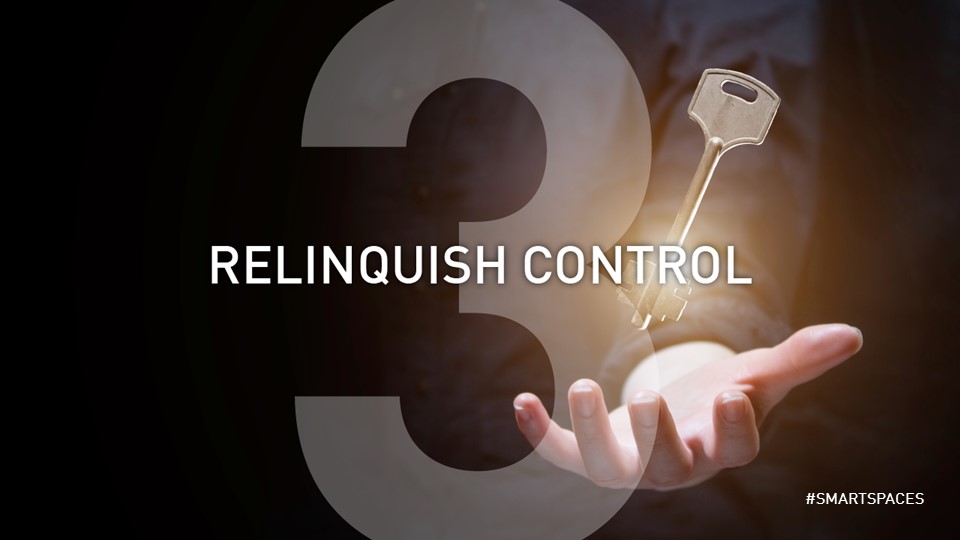
Relinquish Control. Design experiences that let people define the breadth and depth of their engagement, but reward them at every level, no matter how shallow or deep. Trust people to be the captains of their own journey, and let them chart their own course. We need to believe in the innate goodness of all people and let them take control of these experiences, not force them to follow patterns that put down for them. They’ll define their own boundaries.
Give People Superpowers. We can use technology to turn anyone into an artistic virtuoso or magician, regardless of their abilities. And we do it effortlessly, by magnifying small inputs into larger-than-life outputs.
Create Community. We can use technology to break the ice between strangers, encourage cooperation and create collaborative, bonding moments in the real world.
Be Spatially Literate. No matter how much some people try, some things just don’t naturally fit with other things. This rings true in physical spaces as well, which is why it’s crucial to design experiences that are spatially literate: they leverage patterns of past use, user expectations, cultural norms and architecture to be true and appropriate to their physical context. And, you must understand not just the space in which the experience is happening, but also the design intent behind the space. How are people moving throughout the space? Why is the entrance on one wall versus another? Everything you do should support the visitor narrative, which underscores the larger journey that the architect has created within this space.
Welcome Everyone. We can use smart spaces to erase the digital divide. Smart spaces don’t see race/gender/age/income/culture. No need to bring a device; all are welcome and equal.
Ignore the Technology. We see a lot of clients get fixated on specific technologies and approaches, but the truth is, nobody pays to see technology, they pay for an experience. They want to know what they are getting out of it – the emotional response and level of immersion are some of the key components. Pixar gets this right by truly understanding what their audiences want: if you shot their movies with actors instead of all-CGI characters, or could only experience the story through early storyboards or hand sketches, the narrative is still engaging.
Much like the virtual world, the possibilities are nearly limitless. Public spaces should allow anyone to create a unique, gorgeous, animated plaza-scale work of art in seconds, that they’re proud to behold, even if they’ve never picked up a pencil or paintbrush in their life. We can see spaces whose playful soundtrack is created simply by the patterns of those who move through it, revealing new sounds and compositional tools for those who commit time and attention to discover its secrets. We see spaces that break down our social barriers and bring strangers together that never would have stopped to talk had it not been for the shared magical experience of their environment. We see public spaces from the most developed nation to the least, bringing joy and delight to a few seconds of everyone’s day, without them needing to pull a device out of their pocket.
I want to end with author and futurist Arthur C. Clarke’s third law, which posits that “any sufficiently advanced technology is indistinguishable from magic.” In essence, smart spaces are a form of magic, but their real power comes from turning the users of the space into the magicians. Give them the wand and let them pull the rabbit out of the hat. We needn’t reveal our secrets, but it’s up to all of us here to create those wands and leave them where everyone will surely find them and put them to good use.

